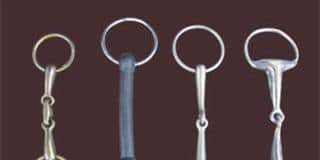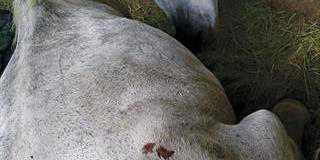Bots are the larvae of the bot fly, which occurs all over the world. They’re related to the nasal worms found in sheep. Adult female bot flies look like small bumble bees and hover around the belly and legs of horses in late spring and early autumn. There are three different species that each lay their eggs in different parts of the horse’s body. Gasterophilus intestinalis, the most common species in South Africa, lays its eggs on the shoulders and legs of horses. G. nasalis lays eggs around the nostrils and G. haemorrhoidalis lays eggs on the hairs around the lips.
Life cycle
Adult females have yellow stripes and a long ovipositor at the rear end. They don’t have mouth parts, as they never feed and live on stored energy after hatching. Bot eggs hatch after about 10 days, when the horse licks its legs or rubs its lips against them. Contact with saliva stimulates the larvae to burrow into the skin, tongue or gums. They incubate in the tissue for about three weeks, then migrate into the mouth, where they’re swallowed. They attach to the mucosal lining in the horse’s stomach and remain there for up to nine months, overwintering, before detaching and passing through the intestines into the manure during the following spring.
The larvae then pupate in the soil. When it’s warm enough, generally after the first rains, they hatch out into adult flies, mate, and the females lay eggs again. If there’s a long, hot summer, there can be two cycles of bots, one in late spring and one in late summer.Symptoms of bot fly infestation.In healthy horses, small numbers of bot larvae will cause little damage, although they can cause erosions on the mucosa, leading to small stomach ulcers.
But heavy burdens of these internal parasites can cause diarrhoea and colic. The larvae can interfere with nutrient uptake and cause blood and serum loss at the attachment sites. This leads to decreased growth in young horses, mineral depletion, low fertility and reduced resistance to disease. The only way to diagnose bots is by using an endoscope to inspect the stomach lining.
They’re also seen during post-mortem examinations. Blood tests are non-specific, although the serum protein may be slightly decreased. Faecal samples won’t test positive for eggs, as these parasites are the larvae of an insect. Sometimes the larvae can be seen in manure when they detach early in spring or in mid-summer. They are oval, about 70mm to 90mm long, and a pinkish colour.
Treating bots
In summer you’ll often see small, oval, yellow bot eggs on the hair of the forelegs and chest of horses, mules and donkeys. They are difficult to remove without a bot knife, which looks like a butter knife with a rounded end and serrated edge. Unless they appear on show horses, spray them with the same dips or insecticides you use to control ticks. In times gone by, the only way to remove the larvae from the stomach was to drench horses with sulphur-containing medications or organophosphates, using a stomach tube.
But most modern oral de-worming remedies are effective against bots, particularly those containing Ivomectin. The best times to treat horses are in mid-December, to remove any mature bots, and again in May, to eliminate any remaining larvae that are overwintering in the stomach.
Contact Dr Mac c/o Chris Nel at [email protected].













